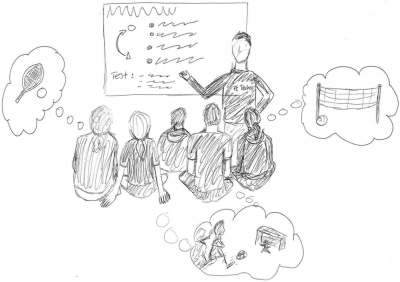
Skaters don’t learn to skate sitting on the ice, listening to a lecture. They learn to skate by moving across the ice step by step. Likewise, anything about physical activity is learned by doing, not listening. It’s called experiential learning, and this is how middle school PE class should be conducted. We spend most of the day immersed in academics, and PE differs from our other classes because the focus should be on activity.
“[Students] spend too much time on the floor because if we are in a physical unit and we’re learning about fitness, we should be experiencing that first-hand rather than talking about that and not doing anything,” said eighth grader Taylor Lewis.
From a middle school survey with 233 respondents, 60 percent of students estimated that 40 percent or more of PE class was spent stationary either listening to instructions, being lectured, or reflecting. In response, Mrs. Hayley Canton, a PE teacher, said, “The key thing for us is it’s called physical education, not gym class, so it’s about educating yourself through physical activity, and it just so happens that some of that time is spent sitting down.”
Although students accept the fact that PE isn’t a free-for-all, many wish that they could have the opportunity to engage more in the physical side of the unit. Of course, there are times when students must be still in order to be given instructions or to briefly reflect, but we don’t think that PE is the place for long static lessons. Furthermore, students have detected repetition in the curriculum. For example, in eighth grade badminton, a theme throughout our lessons was that of competition and its impact on our community. Eighth grader, Emily Forgash said that, “Each class, we speak about competition and it is often the same question rephrased. It seems as if the coversations we have are out of context and it is difficult to see the connection to badminton.”. If the talks we have to sit through aren’t relevant or interesting to the students, then the information just goes in one ear and out the other. Students must be able to apply all the concepts we learn.
Fifty-three percent of student respondents said they wanted more physical activity in PE, and we believe this is a valid request. Moreover, if a majority of the student body is questioning or complaining about the curriculum, then the PE department should adjust accordingly or make their reasoning obvious. Currently, many students don’t agree with the curriculum, and this makes PE unenjoyable. There is a time for words and a time for action, and we think PE class is a time that should be devoted to do the latter.
